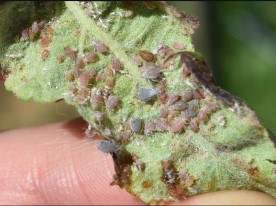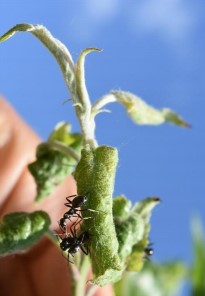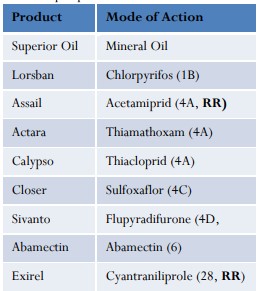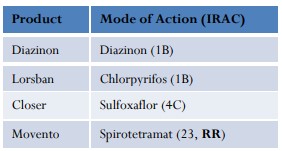Focus on Apple Aphids
Wooly apple aphids have begun to appear in Wisconsin’s orchards, and now is a good time to remind yourself of the different species of aphid that can be found in our apple orchards. There are five species of aphid that are most often seen on apples in Wisconsin. The Rosy Apple Aphid, Dysaphis plantaginea and Wooly Apple Aphid, Eriosoma lanigerum were both discussed last year in the WI Fruit News, Season 1 Issue 8. Rosy apple aphids are most prevalent from tight cluster to pre-pink, and feed on both leaves and the developing flower buds. They may still be present in your orchard, and you can scout for them by looking for curled leaves, then looking on the underside of the leaves for the pinkish-red aphids. Wooly apple aphids become increasingly prevalent as the season goes along, and feed on leaf axils and terminal shoots. A chart comparing how to identify, monitor for, and control these two species is provided in the table below.

The other species of aphid you may see in apple orchards this summer are unlikely to cause significant damage to the trees. The Green Apple Aphid, Aphis pomi, and the Spirea Apple Aphid, Aphis spiraecola, are indistinguishable from each other in the field. While rosy apple aphids are a pink-red color, these other species are yellowish-green. All three species feed on the underside of leaves, and cause leaf curling similarly to the rosy apple aphid. To scout for green and Spirea apple aphids, randomly select 10 shoots (not watersprouts) on each of five trees per block to examine for curled leaves (check to see if leaf curling is caused by these or rosy apple aphid, as the economic threshold for rosy apple aphid is much lower). If, on average, more than four leaves per shoot have aphids, a chemical spray may be warranted.

Another apple aphid, the Apple Grain Aphid, Rhopalosiphum fitchii, appears earlier in the spring than our other aphids, but rarely causes economically significant damage in Wisconsin orchards. Apple grain aphids can be distinguished from other species because their antennae are much shorter than their body-length, and they have a dark stripe running down their back.

For all species of aphids, there are a number of predators and parasitoids present in Wisconsin orchards, which are able to do a pretty good job of keeping their populations under check. However, some broad-spectrum insecticides, in particular pyrethroids, have been shown to reduce populations of these natural enemies, and so may cause an upsurge in aphid numbers. It is recommended to avoid unnecessary broad-spectrum insecticide applications for this reason. If an insecticide spray is required for aphid control, you can refer to the Midwest Fruit Pest Management Guide for recommendations.
Comparing Rosy vs Wooly Apple Aphids
| Rosy Apple Aphid | Wooly Apple Aphid | |
| How to Identify: | 1/50th – 1/10th inch long, reddish-pink with abdominal cornicles and antennae more than ½ as long as body. | 1/16th -1/20th inch long, generally covered in wooly waxy covering, no cornicles and antennae less than ½ as long as body. |
| Damage Symptoms: | • Leaf curling • Misshapen fruit • Stunted fruit development • Sooty and other fungal growth | • Nodules/cankers on roots and woody parts of the tree • Yellowing leaves • Sooty and other fungal growth |
| Timing of Damage: | Tight-cluster through pre-pink, less common in late summer | Throughout summer |
| Monitoring: | Monitor for eggs during the dormant period. Monitor for curled up leaves during spring. | Monitor for nymph and adult aphids throughout the summer. |
| Cultural Control: | • Eliminate plantain and dock • Avoid Cortland, Ida Red, Golden Delicious, Rome, York and Stayman • Keep trees pruned | Plant MM 106, MM 111, G11, G41, G213, G214, G222, G202, G969, G210, or G890 rootstocks, and/or Northern Spy cultivar • Keep trees pruned |
| Biological Control: | Lady beetles, lacewings, syrphid fly larvae, and Braconid wasps | Aphelinus mali wasps, lady beetles, lacewings, and syrphid fly larvae |
| Chemical Control: | Spray during dormant period OR during tightcluster to pre-pink. | Spray during pink to petal-fall. Adding a horticultural oil to the spray can help penetrate the aphids’ “wooly” wax covering. |
Rosy Apple Aphid Chemical Control

Wooly Apple Aphid Chemical Control

RR = reduced risk

